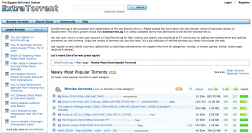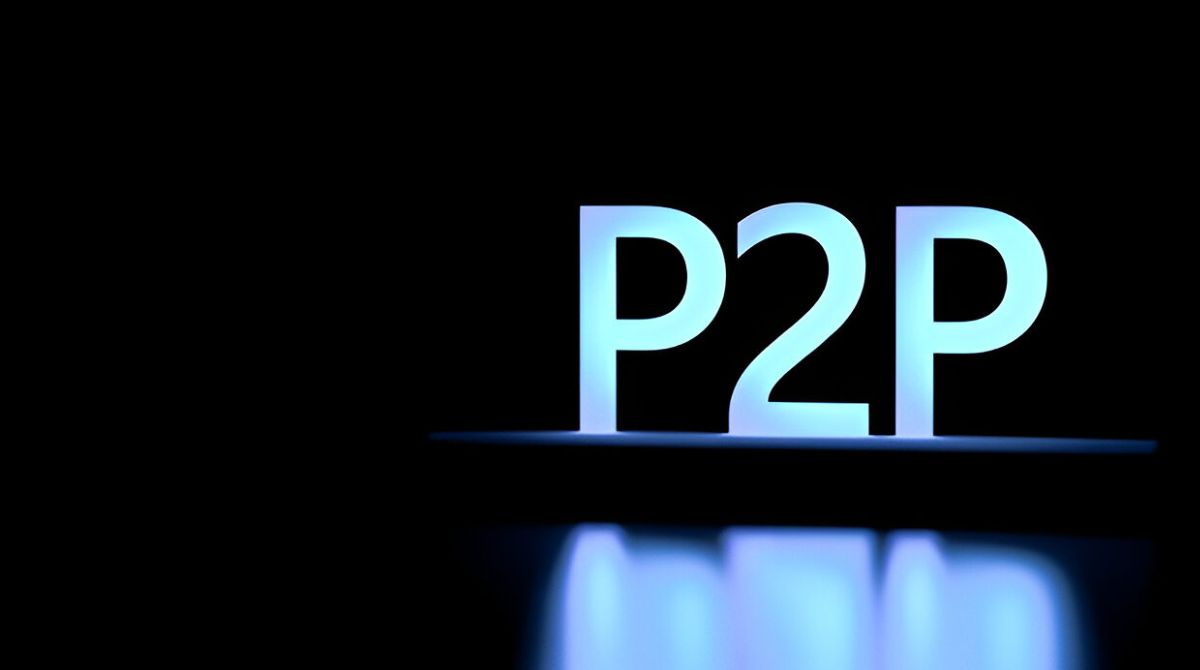Introduction
When it comes to downloading files from the internet, Peer-to-Peer (P2P) file sharing has long been the go-to method for many users. P2P allows users to connect directly to one another to share files, making it popular for downloading torrents.
However, using P2P for torrenting comes with a set of inherent risks. These risks include potential legal consequences due to copyright infringement, exposure to malware and viruses, and the need for a stable internet connection to maintain download speeds.
But fear not! There are alternative methods you can use to get a torrent without relying on P2P technology. In this article, we will explore several effective methods that bypass the traditional P2P approach, ensuring a safer and more efficient way to download your desired content.
Whether you are concerned about your privacy, want to avoid legal issues, or simply want to explore new options, the following methods provide reliable alternatives to P2P for torrenting.
What is P2P?
Peer-to-Peer (P2P) is a decentralized network architecture that allows users to share and download files directly from one another without the need for central servers. In a P2P network, each participant acts as both a client and a server, contributing to the sharing of files.
P2P technology revolutionized file sharing by eliminating the need for a central authority to facilitate the transfer of files. Instead, users connect directly to other users’ computers, forming a network where files can be shared and downloaded simultaneously.
One of the most common applications of P2P technology is torrenting, which involves downloading files using BitTorrent protocol. Torrenting allows users to download large files by downloading small pieces of the file from multiple sources simultaneously. This distributed approach increases download speeds and allows for efficient content distribution.
However, P2P file sharing, including torrenting, has some drawbacks and risks associated with it. First and foremost is the legal aspect. While torrenting itself is not illegal, it is often used to share copyrighted materials without permission. This can result in legal consequences if you download or distribute copyrighted content without authorization.
In addition to legal risks, P2P file sharing also exposes users to potential malware and viruses. Since files are downloaded from multiple sources, there is a risk of downloading files that have been intentionally or accidentally infected with malicious software. This can compromise the security of your computer and put your personal data at risk.
Furthermore, relying on P2P for downloading files requires a stable internet connection and active peers sharing the content you want. If there aren’t enough seeders, you might experience slow download speeds or even fail to download the file altogether.
Considering these risks and limitations, it’s understandable why users might seek alternative methods for getting torrents without relying on P2P technology. In the following sections, we will explore several effective alternatives to P2P for torrenting.
The Risks of Using P2P
While P2P file sharing has been a popular method for downloading torrents, it is important to be aware of the associated risks. By understanding these risks, you can make informed decisions and explore alternative methods for downloading torrents that may better suit your needs.
One of the significant risks of using P2P for torrenting is the potential for legal consequences. Many torrents contain copyrighted material, and downloading or distributing such content without permission is a violation of copyright laws. This can lead to legal action, fines, or even criminal charges, depending on your jurisdiction.
In addition to legal concerns, P2P file sharing exposes users to the risk of malware and viruses. Since files are downloaded directly from other users, there is a chance that someone may intentionally or inadvertently share a file infected with malicious software. This can compromise the security of your device and put your sensitive information at risk.
Moreover, relying solely on P2P for downloading torrents can be frustrating if there are not enough seeders or peers sharing the file you want. In such cases, you may experience slow download speeds or encounter difficulties in completing the download. This can lead to wasted time and frustration, especially when you are eager to access the desired content.
Another consideration is the stability of your internet connection. P2P file sharing relies heavily on maintaining a stable connection with other peers. If your internet connection is unreliable, it can disrupt the download process and result in incomplete or corrupted files.
Additionally, the transparency of P2P file sharing can lead to privacy concerns. Since your IP address is visible to other peers while downloading or uploading files, it is possible for your online activities to be tracked. This lack of anonymity can be problematic for those who value their privacy and want to protect their identity while using the internet.
Given these risks, it is understandable that many users are seeking alternatives to P2P for downloading torrents. In the following sections, we will explore several effective methods that provide a safer and more reliable approach to acquiring torrents.
Alternatives to P2P for Torrenting
While P2P file sharing has been the traditional method for downloading torrents, there are alternative approaches that offer a safer and more reliable experience. These alternatives provide different ways to obtain torrents without relying on P2P technology. Let’s explore some of these methods:
1. Usenet: Usenet is a distributed network that predates the internet as we know it today. It operates on a subscription-based model and offers access to a vast array of content, including files and discussion forums. Usenet provides high-speed downloads, excellent reliability, and a higher level of security compared to traditional P2P torrenting.
2. Direct Downloads: Direct download websites, or DDL sites, offer a straightforward way to download files without using P2P technology. These sites host files on their own servers, allowing users to download content directly from their servers via a web browser. DDL sites often offer a wide range of files, including movies, TV shows, software, and more.
3. Seedboxes: A seedbox is a dedicated server that is used to download and upload torrents. It provides high-speed downloads and offers a buffer between the user and the torrent network, enhancing both security and privacy. Once the files are downloaded to the seedbox, the user can then download them directly to their device using FTP or other file transfer methods.
4. VPNs: Virtual Private Networks, or VPNs, encrypt your internet connection and provide a secure tunnel for your online activities. By using a VPN, you can mask your IP address, making it difficult for others to track your online activities. Additionally, VPNs can bypass certain restrictions and allow you to access torrenting sites that may be blocked in your region.
5. Cloud Torrenting: Cloud torrenting services allow you to download torrents directly to the cloud. With cloud torrenting, the torrent files are downloaded and stored in your cloud storage account, eliminating the need for P2P connections. This method offers convenience and accessibility, as you can access your downloaded files from various devices.
These alternative methods provide reliable options for downloading torrents without relying on P2P technology. Each method has its own strengths and features, so it’s important to consider your specific needs and preferences when choosing the most suitable alternative for you.
Method 1: Usenet
Usenet is an alternative method to P2P for downloading torrents that offers several advantages. It operates on a subscription-based model and provides users with access to an extensive network of newsgroups, allowing for secure and high-speed downloads.
One of the key advantages of Usenet is its reliability. Unlike P2P file sharing, which relies on the availability of peers, Usenet downloads from multiple servers simultaneously. This redundancy ensures that even if one server is offline or unavailable, you can still access and download the desired files from other servers.
Moreover, Usenet provides higher download speeds compared to traditional P2P torrenting. This is because Usenet connections are typically not limited by upload speeds or constraints imposed by other users. The files are downloaded directly from Usenet servers, resulting in faster and more consistent download speeds.
Privacy is another significant benefit of Usenet. Unlike P2P file sharing, Usenet downloads are not peer-to-peer. Instead, you connect directly to Usenet servers, which means that your IP address is not exposed to other users. This added layer of privacy can give users peace of mind while enjoying the benefits of torrenting.
Using Usenet for torrenting involves the use of specialized software called a Usenet client, which allows you to search for and download files from Usenet newsgroups. Once you find the desired file, the client connects to the Usenet server and retrieves the file directly to your device.
It is important to note that access to Usenet requires a subscription to a Usenet provider. These providers offer different plans with varying storage capacities and download limits. Some providers also offer Usenet indexers, which are search engines specifically designed for Usenet newsgroups, making it easier to find the files you need.
Overall, Usenet provides a reliable, fast, and secure alternative to P2P for downloading torrents. With its extensive network, high download speeds, and enhanced privacy, Usenet is a popular choice for those seeking a more efficient and hassle-free torrenting experience.
Method 2: Direct Downloads
Direct downloads offer a straightforward alternative to P2P for downloading torrents. Instead of relying on P2P connections, direct download websites, often referred to as DDL sites, allow users to download files directly from their servers.
DDL sites host files on their own servers, which means that you don’t need to rely on other users for file sharing. This eliminates many of the risks associated with P2P file sharing, such as exposure to malware and legal consequences. Additionally, DDL sites often offer a wide variety of files, including movies, TV shows, software, music, and more.
Downloading from DDL sites is typically as simple as visiting the site, locating the file you want, and initiating the download. The files are hosted on high-speed servers, ensuring faster and more stable download speeds compared to P2P. This can be especially beneficial for larger files that may take longer to download through traditional P2P torrenting.
One advantage of direct downloads is the accessibility and convenience they offer. You can access these sites through a web browser on any device with an internet connection, without the need for any additional software or specialized clients. This makes direct downloads suitable for users who are not familiar with or prefer not to use torrent clients.
While direct downloads have their advantages, it is important to note that some DDL sites may require registration or a premium account to access certain files or to download files at higher speeds. Additionally, the availability of files may vary across different DDL sites, so it’s a good idea to explore multiple sites to find the specific files you are looking for.
It’s worth mentioning that similar to P2P file sharing, copyright infringement is still a concern when using DDL sites. Ensure that you are downloading and sharing files that are legal and do not violate copyright laws to avoid any potential legal consequences.
In summary, direct downloads offer a convenient and reliable alternative to P2P for downloading torrents. With their easy accessibility, faster download speeds, and reduced risks, DDL sites provide a viable option for users who prefer a straightforward and hassle-free approach to accessing the files they desire.
Method 3: Seedboxes
Seedboxes provide an efficient and secure method for downloading torrents without relying on traditional P2P connections. A seedbox is essentially a dedicated server designed for downloading and uploading torrents.
One of the key advantages of using a seedbox is the enhanced download speed. Seedboxes are typically connected to high-speed internet connections, which allow for faster and more consistent download speeds compared to regular home internet connections. This means that you can quickly download your desired torrents to the seedbox and then transfer them to your personal device at high speeds.
Seedboxes also offer greater reliability and stability in the downloading process. Since seedboxes are dedicated servers, they are constantly connected to the internet, ensuring uninterrupted downloads. Unlike P2P connections that rely on the availability of peers for downloading, seedboxes use their own connections to fetch the files, resulting in more reliable and efficient downloads.
Privacy and security are also major benefits of using seedboxes. Since the downloading and uploading of torrents happen on the seedbox server, your IP address is not exposed to other peers, providing an additional layer of anonymity. This can be especially important if you want to protect your privacy or avoid potential legal issues associated with P2P torrenting.
Using a seedbox involves a few steps. First, you need to subscribe to a seedbox service, which will provide you with storage space on their server and a dedicated torrent client to manage your downloads. Once you have chosen a file or torrent to download, you add it to the client on the seedbox, and the server will download it for you. Finally, you can transfer the downloaded file from the seedbox to your personal device through secure methods like FTP or SFTP.
It’s important to note that seedboxes do come with associated costs. Most seedbox providers offer different plans with varying storage capacities and features, and you will need to choose a plan that suits your needs. However, the benefits of faster downloads, enhanced privacy, and improved security make seedboxes a popular choice for those seeking an efficient and secure way to download torrents.
In summary, seedboxes offer a reliable, high-speed, and secure alternative to traditional P2P torrenting. With their dedicated servers, faster download speeds, and added privacy measures, seedboxes provide users with a seamless and efficient method to download and manage torrents.
Method 4: VPNs
Using a Virtual Private Network (VPN) is an effective way to download torrents without relying on traditional P2P connections. VPNs provide an added layer of privacy and security by encrypting your internet connection and routing it through a remote server.
One of the primary benefits of using a VPN for torrenting is enhanced privacy. When you connect to a VPN server, your IP address is masked, making it difficult for others to track your online activities. This can be particularly important when downloading torrents, as it helps to protect your identity and maintain your online anonymity.
Additionally, VPNs can help bypass certain restrictions and access torrenting sites that may be blocked in your region. By connecting to a VPN server in a different location, you can circumvent geographical restrictions and freely access the torrent sites you want, expanding your options for downloading content.
Another advantage of using a VPN is the added security it provides. The encryption applied by VPNs helps protect your data from potential threats, such as hackers or malicious users, when downloading torrents. This can help prevent unauthorized access to your personal information and ensure a safer torrenting experience.
When using a VPN for torrenting, it’s important to select a VPN provider that allows P2P traffic and offers fast and reliable connections. Look for a VPN service that has servers located in countries where P2P sharing is legally allowed and that does not keep logs of your online activities for maximum privacy.
To use a VPN for torrenting, you typically need to install VPN software on your device and connect to a server of your choice. Once connected, all your internet traffic will be encrypted and routed through the VPN server, providing the necessary privacy and security for downloading torrents.
It’s worth noting that while VPNs offer many benefits for torrenting, it’s still important to exercise caution and ensure that you are downloading and sharing content legally. Respect copyright laws and only download or distribute files that you have the necessary rights or permissions to access.
In summary, using a VPN is a reliable and secure method to download torrents while protecting your privacy and security. By encrypting your connection and masking your IP address, VPNs allow you to bypass restrictions, maintain anonymity, and enjoy a safer torrenting experience.
Method 5: Cloud Torrenting
Cloud torrenting offers a convenient and efficient alternative to traditional P2P connections for downloading torrents. With cloud torrenting, you can download and store files directly in the cloud, eliminating the need for P2P connections and providing flexibility and accessibility.
One of the significant advantages of cloud torrenting is the ability to access your downloaded files from anywhere and on any device. Since the files are stored in the cloud, you can log in to your cloud storage account and download the files to your device whenever and wherever you need them. This makes it convenient for users who want to access their files on multiple devices or share them with others.
Cloud torrenting also offers enhanced privacy and security. With your files stored in the cloud, the downloading and sharing happen directly with the cloud storage provider, rather than relying on other peers. This reduces the risk of exposure to malware and protects your personal information. Additionally, some cloud storage providers offer encryption options to ensure the security and privacy of your stored files.
Another advantage of cloud torrenting is the potential for faster downloads. Cloud storage providers often have high-speed servers that can retrieve files quickly. This means that you can enjoy faster download speeds compared to traditional P2P connections where download speeds can be dependent on the availability and speed of other peers.
To use cloud torrenting, you typically need to sign up for a cloud storage service that supports torrenting. Many cloud storage providers offer dedicated torrenting features or integrate with torrent clients. Once you have selected a provider, you can add the torrent file or magnet link to the provided interface, and the cloud storage provider will start downloading and storing the file in your account.
It’s important to note that some cloud storage providers may have limitations on the amount of storage or the number of files you can store. Depending on your needs, you may need to choose a plan that offers sufficient storage capacity for your torrenting requirements.
Overall, cloud torrenting offers a flexible, secure, and convenient way to download and store torrents. With the ability to access your files from anywhere, enhanced privacy and security measures, and the potential for faster downloads, cloud torrenting is a popular option for those looking to optimize their torrenting experience.
Conclusion
In conclusion, there are several alternatives to Peer-to-Peer (P2P) file sharing for downloading torrents. Each method offers its own unique benefits and can cater to different user preferences and needs.
Usenet provides a reliable and high-speed approach to downloading torrents, with its vast network of newsgroups and enhanced privacy features. Direct downloads offer convenience and accessibility, allowing users to download files directly from websites without the need for additional software or complex setups.
Seedboxes provide users with faster and more stable download speeds, along with enhanced privacy and security. By utilizing dedicated servers, seedboxes offer reliable and efficient torrent downloads.
VPNs offer an added layer of privacy and security by encrypting your internet connection and masking your IP address. They can help bypass restrictions, access blocked torrenting sites, and protect your personal information while downloading torrents.
Cloud torrenting provides flexibility, accessibility, and the ability to store and download files directly from the cloud. With the potential for faster downloads and the convenience of accessing files on multiple devices, cloud torrenting can be an excellent option for users seeking convenience and versatility.
When exploring these alternatives, it’s important to keep in mind legal considerations and respect copyright laws. Ensure that you download and share files that are authorized and legal to avoid any potential legal consequences.
Ultimately, the choice of the alternative method to P2P for torrenting depends on your specific needs, preferences, and level of comfort with each approach. Consider your desired download speeds, privacy requirements, storage options, and ease of use when deciding which method is best for you.
With these alternative methods, you can enjoy a safer, faster, and more reliable torrenting experience while minimizing the risks associated with traditional P2P file sharing. Embrace the opportunities provided by these alternatives and discover the method that suits you best for your torrenting needs.

























